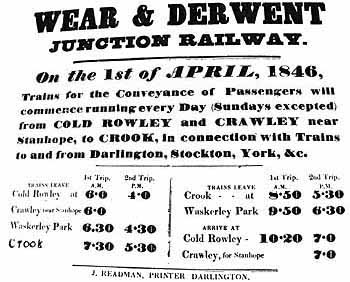 |
Notes: Parkhead was opened as a goods only station but early
Stockton & Darlington passenger tickets exist showing Parkhead
- Bishop Auckland and back. An article by Dr. T M Bell in the
North East Express (May 2002) refers to an unsigned and undated
lease to let R. Cordner of Crawley House to use a line from
a junction on the Weatherhill & Rookhope, 3 miles from |
Park
Head on the Stanhope & Tyne to Low White Heaps. Conditions
included provision, weather permitting, for a passenger train
to Park Head and back on Darlington & Bishop Auckland market
days. It is not certain whether the service actually ran but
the lease implies that some sort of service must have existed
over the line in order to get passengers to markets. If the
service did run it's unlikely to have lasted beyond October
1862 when the direct line to Stanhope was opened.
Parkhead was later known as Blanchland and this name was officially
adopted from 1.7.1923.
BRIEF HISTORY OF THE STANHOPE
& TYNE RAILWAY (Stanhope - Blackhill)
This early railway was opened in 1834 to transport limestone
from the quarries above Stanhope in Weardale and coal from the
various collieries in North Durham to South Shields. Its consulting
engineer was Robert Stephenson and the line was built without
an Act of Parliament and by means of 'Wayleaves' where the company
paid the landowner an annual rent for crossing their property.
Not surprisingly as word got out so the landowners started asking
for extortionate rents and the line was bankrupt by 1840. The
section from Consett to the Tyne was taken over by the newly
formed Pontop & Tyne railway while the rest southwards was
bought by the Derwent Iron Company to ensure a supply of limestone
to the iron works at Consett which had been established following
the discovery of iron ore in the area. It became know as the
Derwent Railway.
 |
The line had to rise several hundred feet
out of Weardale by means of inclined planes and winding
engines at Crawley and Weatherhill; the summit was worked
by horses and the traffic was lowered northwards by means
of another winding engine and the self-acting Nanny Mayors
incline.
More horse working followed after which traffic was lowered
down one side and hauled up the other side of Hownes Gill
and then hauled by rope to the iron works. |
The Derwent Iron Company was looking for an outlet to the south
and itself considered building a line towards Crook and the
Stockton and Darlington Railway but in the end it was the S&D
who constructed the Weardale Extension Railway from Crook, via
the Sunniside incline and Tow Law, on behalf of the Derwent
Iron Company and which subsequently purchased the Derwent Railway.
The line, opened to traffic in 16 May 1845, joined the former
Derwent Railway at Waskerley, at the head of Nanny Mayors Incline
where a small railway village developed on the top of the moors.
The Stockton and Darlington replaced the inclines by deviations
suitable for locomotives except at the Stanhope end where the
two inclines survived until 1951. Hownes Gill inclines were
replaced by a fine viaduct (still standing) in 1859 and in the
same year a new line, avoiding Nanny Mayors Incline, facilitated
through working from Crook to Consett, traffic from Stanhope
and Waskerley northwards now having to reverse at the new Burnhill
Junction. A station was built at Burnhill on the new deviation
line about half a mile north of the junction and footpath connected
it to Waskerley across the moor. Just before the new Hownes
Gill Viaduct a spur line was constructed bringing the S&D
line down to the Lanchester branch of the NER and passenger
traffic was diverted to the station at Blackhill on the western
side of the new town of Consett
The line from the Crawley incline above Stanhope to Crook carried
passengers from 1 September 1845 but no stations were initially
provided beyond Tow Law. (The S&D did advertise for tenders
for Waskerley in 1846 but almost immediately canceled it and
a station was provided for Rowley instead). The passenger service
was cut back from Crawley to Waskerley in October of the same
year, resuming on 1 April 1846 but was finally withdrawn at
the end of the year and not resumed again. The service from
Crook to Waskerley survived until 1859 when the deviation line
was opened and services northwards diverted via the new Burnhill
station.
With increasing competition from roads and the decline in the
handling of lime and stone the line north of Tow Law to Blackhill
(Consett) was closed to passengers in May 1939. The original
route across the moors from Waskerley survived intact until
1951 when the inclines above Stanhope were closed and Weatherhill
became the terminus until all traffic ceased on this original
Stanhope and Tyne route from 1 May 1969
Click here
for additional history of the Stanhope & Tyne Railway. Ticket from Michael Stewart
To see the other
stations on former Stanhope & Tyne line click on the station
name: Waskerley,
Burnhill, Rowley
& Blackhill
Click here
for other views of the Stanhope & Tyne Railway
See also Stations on the Bishop
Auckland - Burnhill line
Derwent Valley Railway
Lanchester Valley Railway
|






 Home Page
Home Page 







